Top 5 HubSpot Alternatives in 2024 based on 35,000 Reviews
More than 90% of consumers are more likely to make an additional purchase after a positive customer service experience.1Customer service is essential because it serves as a direct link between consumers and the company
Hubspot Service Hub is one of the help desk software providers; however, there may be alternative solutions for customers that are better suited to your company’s specific use cases. There are tens of other help desk software products on the market, and enterprises may prefer other alternatives depending on their cost, functionality, or features.
Thus, we’ve conducted detailed research on HubSpot Service Hub, its drawbacks, and the top 5 alternatives that could support your company’s customer experience strategy.
The following points will be highlighted for each alternative:
- An overview of the software
- Top features
- User ratings
- Pros and cons
- Pricing
Comparison of HubSpot and its top 5 alternatives
| Vendors | Total reviews* | Average rating* | Total # of emloyees | Free Trial | Pricing** |
|---|---|---|---|---|---|
| HubSpot Service Hub | 2,246 | 4.3/5 | 9,454 | 14-day | $18.00 |
Zendesk Support Suite | 10,377 | 4.2/5 | 6,372 | 30-day | $55.00 |
Salesforce Service Cloud | 4,601 | 4.4/5 | 71,372 | 30-day | $25.00 |
Freshdesk | 6,630 | 4.4/5 | 12,957 | 14-day | $15.00 |
| Intercom | 4,408 | 4.5/5 | 1,343 | 14-day | $39.00 |
| Zoho Desk | 7,238 | 4.4/5 | 6,054 | 15-day | $7.00 |
*Based on the total number of reviews and average ratings on the Capterra, G2, and TrustRadius software review platforms as of 10/24/2023. Average ratings are aggregated on a 5-point scale.
**Starting price per seat/month, billed annually
| Vendors | Intelligent Chatbots | Case Management | Time Tracking | Visual remote assistance | Cloud voice | Software & app integrations | Supported languages |
|---|---|---|---|---|---|---|---|
| HubSpot Service Hub | ✅ | ✖ | ✖ | ✅ | ✖ | 1000+ | 14 |
Zendesk Support Suite | ✅ | ✅ | ✅ | ✖ | ✅ | 1200+ | 30+ |
Salesforce Service Cloud | In premium plans | ✅ | ✅ | ✅ | ✅ | 2500+ | 35+ |
Freshdesk | ✅ | ✅ | ✅ | ✖ | ✖ | 650+ | 30+ |
| Intercom | ✖ | ✖ | ✅ | ✖ | ✖ | 350+ | 44+ |
| Zoho Desk | In premium plans | ✅ | ✅ | ✅ | ✅ | 5000+ | 40+ |
Note: With Hubspot Service Hub at the top followed by sponsored vendors Zendesk Support Suite and Salesforce Service Cloud, we’ve alphabetically listed the vendors.
Vendor selection criteria
In our comparison list, we’ve identified the top HubSpot Service Hub alternatives on topics such as:
- Number of reviews: 2,000+ total reviews on Capterra, G2, and TrustRadius.
- Average rating: 4.0+/5 on Capterra G2 and TrustRadius.
- Total number of employees: 1,000+ employees on LinkedIn
Note: Omnichannel service, self-service, and performance management features are excluded from the comparison list since they are available in all HubSpot alternatives.
HubSpot Customer Service Service Hub
Hubspot is a US-based company founded in 2006.2Service Hub is one of its products, a cloud-based customer service platform that assists small, medium, and large businesses in managing customer interactions.
The Service Hub platform includes a single service module that allows companies to organize customer information while tracking the progress of conversations and funnels across various communication channels (e.g., messaging, chat, email, and phone) with real-time analytics and AI.
User Ratings
- Capterra: 4.4/5
- Trustradius: 8.4/10
- G2: 4.4/5
Pros
- Knowledge base: HubSpot Service Hub has a rich knowledge base; there are numerous FAQ-answering video guides available.3
- User Interface: The platform has a simple user interface, reducing training needs.4
- Feedback tools: HubSpot’s customer feedback survey features are well-appreciated by users, helping them to collect insights from their consumers’ experiences.5
Cons
- No time-tracking feature: Users emphasize that tracking meetings and measuring the service team’s workload on HubSpot would be quite beneficial.6

- Lack of customization in reports: According to some users, the custom reporting features on the platform are insufficient. Users cannot view the types of tickets and product issues within the Service Hub.7

- Insufficient functionality in the UI: According to users, the UI is not completely customizable, and users cannot display the customer in the ticket overview.[/efn_note8
- Lack of AI in ticket management: It would be helpful if the ticketing system included AI to assist users in categorizing tickets into pipelines.910
- Rising costs: For some users, HubSpot might become expensive as pricing scales with new contacts.11
What to look for while choosing HubSpot Service Hub alternatives?
While looking for the best solution for your company, it is vital to understand which aspects can compensate for HubSpot Service Hub’s limitations. Concerning the emphasized drawbacks of the software (see above), here is a list of aspects to consider while searching for Service Hub alternatives.
- Time tracking
- Custom reporting
- Functional user interface
- Automation in ticket management
- Case management
Top 5 HubSpot Service Hub alternatives
1- Zendesk Support Suite
Zendesk, with over 170,000 registered users and operating in 160 countries, is a software-as-a-service platform driven by AI and ML. 12Its customer service platform, Zendesk Support Suite, enables organizations to deliver customized customer service across various channels such as emails, audio, messaging, and social media in a single unified service workspace.
During customer interactions, the system allows agents to use automated triggers instantly when service agents are requested to help customers. Also, the platform uses machine learning to leverage quantitative insights into customer sentiment, such as customer sentiment and agent effectiveness, assisting organizations in fostering positive support services.
User Ratings
- G2: 4.3/5
- Capterra: 4.4/5
- Trustradius: 7.9/10
Pros
Case Management: The real-time case management feature functions seamlessly while tracking and reviewing customer support cases or generating dashboards to measure case data.13
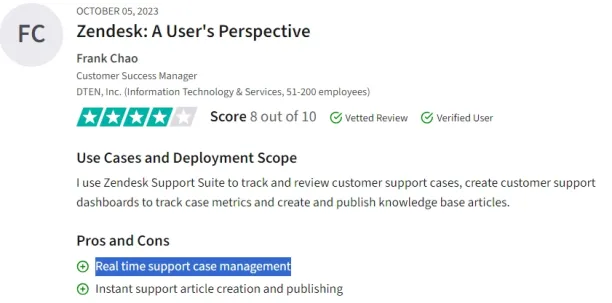
Ease-of-use: Zendesk Portal is easy-to-use for daily tasks.14
Reporting: Users appreciate the fact that Zendesk displays a consolidated reporting history of each participant’s interactions.15
Cons
Bugs: There are a few shortcomings that slow down the workflow (some user’s tickets crashed or their saving notes displayed errors when they were posted correctly).16

Response times: The customer service agents’ response time is long.17
Functionality: More precise information can be provided on whether a message was sent to the end user.18
2- Salesforce Service Cloud
Salesforce Service Cloud is an all-in-one, centralized, cloud-based customer service solution. It can maintain customer interactions across a variety of contact channels, including email, messages, real-time chat, and social media, using built-in artificial intelligence (AI) and CRM automation.
Service Cloud provides a variety of applications and add-ons, beginning at $50 per user/month. Some examples are shown below.19
Service Cloud Einstein: The Cloud Service Einstein is an AI-powered intelligent chatbot that helps organizations by providing 24/7 customer support and automating routine tasks. Also, Einstein chatbots may leverage machine learning (supervised and unsupervised) while analyzing historical customer interactions and data to make predictions and provide customized recommendations.
Visual remote assistant (VRA): VRA connects customers with service agents from any location over video chat without requiring them to be physically present.
Service Cloud Voice (SCV): Service Cloud Voice (SCV) allows agents to answer and make calls and resolve customer issues from a single cloud-based interface.
Real-time monitoring: Real-time monitoring allows you to monitor and identify events in real-time.
User Ratings
- Capterra: 4.4/5
- Trustradius: 8.8/10
- G2: 4.3/5
Pros
- Time tracking: The time tracking feature functions successfully.20
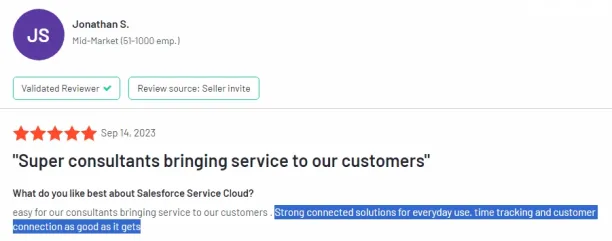
- Case Management: Users appreciate utilizing Service Cloud’s case management feature.21
- Customization: Service Cloud provides an in-depth view of customers preferences and needs, enabling users to customize their customer experience.22
Cons
- User interface: Some users find the interface complex and require various third-party applications to utilize certain features.23

- Costs: Service Cloud may get expensive; costs pile up when users add the variety of feature options, even the most basic ones.24
- Performance: The platform can get slow and unstable; if you keep your tabs open for an extended time, you will lose them all since the system will reset itself.25
3- Freshdesk
Freshdesk was launched in 2010 in the US. It is currently used by over 150,000 businesses.26
77% of businesses that use Freshdesk have achieved improvements in their workflows.27Freshdesk is cloud-based customer service software from Freshworks that offers customized service procedures to organizations while managing customer interactions. The software provides omnichannel capabilities, automatic ticket routing, detailed reporting, SLA management, and self-service options.
It can track and handle incoming tickets from several channels in one place and automate repetitive procedures, including agent allocation, depending on selected parameters such as agent workload, ticket prioritization, or staff availability.
User Ratings
- G2: 4.4/5
- Capterra: 4.5/5
- Trustradius: 8.6/10
Pros
- Automation: Freshworks’ automation features have received positive credit from users in reducing manual work, boosting productivity, and ensuring prompt responses to customer interactions.28
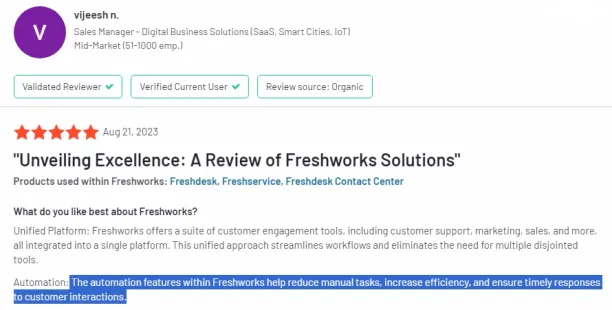
- Ease-of-use: Freshdesk is simple to use and understand, and it runs quickly.29
- Time tracking: Users find it quick and simple to manage tickets by leveraging time tracking on each task.30
Cons
- Ticket management: Merging tickets is not particularly “intelligent”; when long tickets are merged, the additional ticket is placed as a note in its entire form, resulting in a lot of duplication of data and excessive scrolling.31
- Reporting: The reporting features could have more customization features.32
- Integrations: Slack integration is limited; more functions via slack integration can be developed.33
4-Intercom
Intercom is a customer support system to help businesses assist their customers (and potential customers) throughout their customer journey with 24/7 global support, automated answers in 38 languages, and 350+ integrations for your CRM, email, ticketing, and internal databases.34
User Ratings
- G2: 4.5/5
- Capterra: 4.5/5
- Trustradius: 8.8/10
Pros
- Live chat: Intercom’s interactive live chat and research functions are considered to be useful features for the help center team.35
- Email settings: Users can efficiently customize email settings such that incoming email can be filtered, sorted, and delivered directly to the appropriate members.36
- User interface: Intercom has a user-friendly, easy-to-use interface.37
Cons
- Knowledge base: Users state that it is difficult to find precise answers in the knowledge base.38
- Notifications: Back-end user notifications might be improved. Some users don’t always get the chat notification until the user has been sitting there for a few minutes.39
- Interface customization: Users have no control over the default interface types, such as heading types. For example, users cannot modify the text size, hue, background color, or highlighting.40
For more information about Intercom and its alternatives please check out our data-driven and transparent article on Intercom Alternatives.
5- Zoho Desk
Zoho Desk, headquartered in Chennai, India, with 50,000 customers and 12,000+ employees, is a versatile customer service software that includes contextual AI to help organizations of all sizes prioritize, manage, and address customer requests across numerous communication channels, including text, phone, and social media.4142
With Zoho Desk, users can create a knowledge base to empower their staff and improve self-service features. Also, users can leverage analytics to gain meaningful customer insights into their operations and performance, such as customer churn rate, conversion rate, or agent performance.
The platform leverages conversational AI in its intelligent widget solution called “Zia” (offered in enterprise/ultimate plans, starting at $41 per user/month, billed annually) to provide benefits to organizations in formulating a customer experience .43
Zia: Zia is a conversational AI support assistant who improves the effectiveness of your customer service team through data mining and machine learning. Zia delivers customer analytics to support agents using a pre-configured system of statistical analysis for identifying anomalies and trends, evaluating customer sentiment, and providing solutions. Zia is also always learning, meaning that the more synthetic data it has, the smarter it becomes.
User Ratings
- G2: 4.4/5
- Capterra: 4.5/5
- Trustradius: 8.9/10
Pros
- User interface: Its interface is simple, and users with no experience may use it without difficulties.44
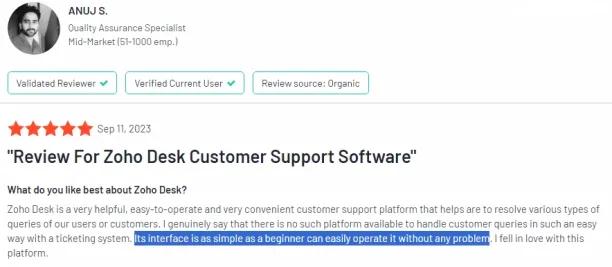
- Automation in ticket management: Users give credit to Zoho’s automation and macro features, decreasing their response times and freeing up agents.45
- Case Management: Users remark on the efficient case management feature with a central station to track internal queries and requests.46
Cons
- Desktop application: There is no desktop application for Zoho Desk.47
- Interface design: The location of the shortcut icon for recent items can be improved.48
- Ticketing system: The ticketing system does not allow users to include sales tax and other fees in the invoices.49
For more information about Zoho Desk and its alternatives please check out our data-driven and transparent article on Zoho Desk Alternatives.
Top 12 features of customer service software
1- Intelligent chatbots
Figure 4: Example of an intelligent chatbot
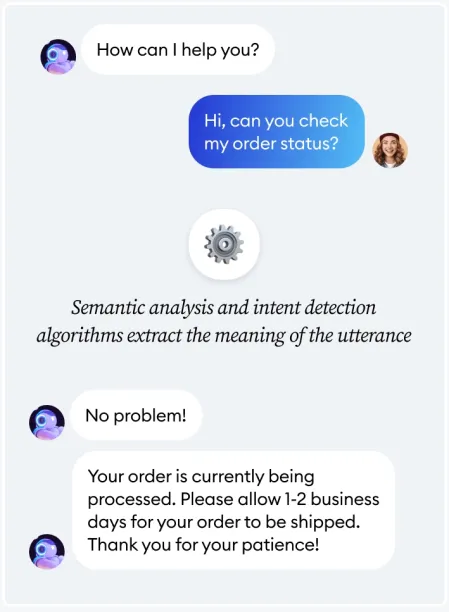
Source:Tidio50
A chatbot is an interactive platform that provides customer service through messaging, voice instructions, or both on various channels, including brand websites, applications, or social media sites.
According to PWC, the most important aspects of a successful customer experience strategy are speed, convenience, and consistency.51
In this regard, chatbots have numerous benefits, such as:
- Delivering 24/7 support: Provide details on products or services
- Offering customized service: Making appropriate product or service recommendations based on customer interests, activities, or demographics
- Eliminating unnecessary tasks: Displaying an order’s status without requesting order details
2- Case management / Incident management
Figure: Example of a support ticket with a case management feature
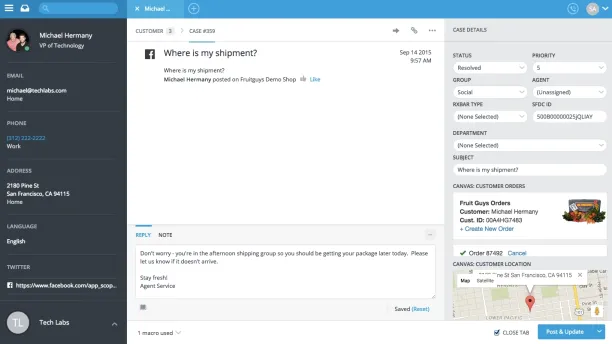
Source: TrustRadius52
~80% of service agents feel it’s challenging to maintain a balance between quality and speed while answering customer questions.53Without a case management system, employees spend significant time looking through past tickets or transferring unsolved issues around the organization.
A case management system helps you efficiently deliver assistance to clients, vendors, partners, and internal stakeholders by issuing a ticket (or incident ID) for each support query. You may use it to follow the problem from start to finish, regardless of whether you are a client, partner, support representative, or supervisor.
With the case management feature in customer service software, organizations can:
- Provide scalable client service
- Resolve incidents faster
- Manage inquiries from all channels.
- Provide agents with an extensive view of the customer
- Show the entire chronology of the customer incident
3- Time tracking
Figure: Example of a timesheet screen
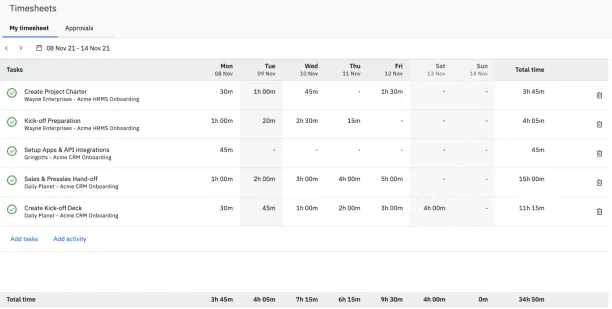
Source: Rocketlane54
Companies use time tracking to record the hours worked by employees. A time-tracking feature in customer service software makes this process more methodical and provides data on how well agents manage their time.
With time tracking service, teams may utilize timesheets to document the time (hours or minutes) they invest in each project and task.
4- Visual remote assistance
~70% of users chose visual assistance, suggesting a preference for getting visual guidelines online.55Visual remote assistance enables service agents to visually resolve a problem for a customer while guiding them through the whole process and providing a solution on-screen by allowing customers to contact customer support, field employees, or cloud specialists.
Visual remote assistance helps users with digital video types such as:
- Video clips
- Automatic recordings
- Computer sharing
- Augmented reality
5- Cloud voice
Figure: Example of a cloud voice assistant
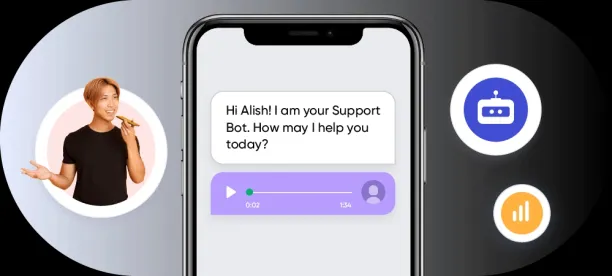
Source: Verloop.56
More than 90% of customers are happy with their voice assistants, enabling them to multitask and receive immediate answers to inquiries.57
Service cloud voice enables agents to directly react to customer inquiries and conduct communication from the service portal.
Some of the main benefits of Service Cloud Voice are as follows:
- Companies may deliver more specialized service
- Service agents can handle calls more efficiently, lowering the average response time
- Service supervisors may view all inbound and outbound calls, online records, and agent or customer insights in real-time.
6- Omnichannel service
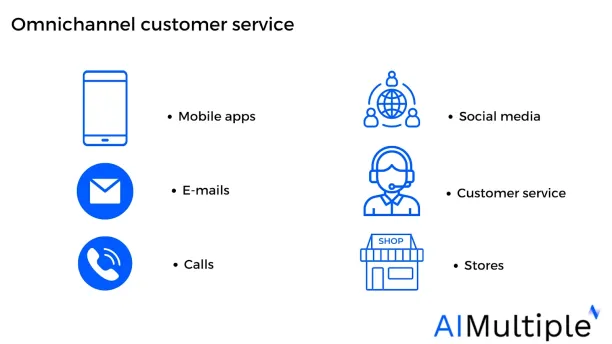
73% of consumers prefer searching for information on a business’s website. Customers seek quick and straightforward ways to communicate with businesses through simple channels.58
Omnichannel customer service is a strategy that generates integrated, seamless consumer interactions among channels to foster a successful customer experience. A chatbot, for instance, may be used to contact customer service. If their problem may take a long time to address, they may be offered the option of receiving a reply by email.
Omnichannel service can help businesses to:
- Increase company revenue: Customers who use omnichannel services spend nearly twice as much as those who use a single channel.59
- Lower customer churn ratios: Companies that provide consistent, high-quality service across several channels keep ~90% of their consumers.60
- Increase operational efficiency: More than 70% of leaders argue that combining teams and responsibilities centered on the customer experience will improve operational efficiencies.61
7- Performance management
Performance management is the process of tracking, evaluating, and enhancing the performance (KPIs) of your customer service center.
Providing high-performance experiences is critical for client retention. ~60% of consumers will not purchase a brand because of poor customer service.62
Important performance management metrics to follow:
- First response time
- Churn rate
- Conversion rate
- Average queue wait time
- Average resolution time
- Customer Satisfaction Score (CSAT)
8- Self-service
More than 60% of US consumers choose autonomous self-service solutions for routine customer support activities. Individuals prefer to use technology rather than chat with a customer support agent.63
Self-service content allows consumers to solve their issues before contacting a customer support person. When it comes to resolving common problems, ~90% of consumers expect to be able to use a self-service support center.64
Self-service documentation can be distributed through:
- FAQ base
- Blog posts
- Chatbots
- Community forums
- Social media forums
Other features to consider while selecting customer service software
9- Social media integrations
Social media integration is a marketing approach that allows businesses to expand their advertising and branding efforts by utilizing social media.
- 55% of customers learn about new brands through social media.65
- ~80% of customers are more likely to buy from a brand following a positive social media interaction.66
- ~70% of customers stated that social media allows them to communicate with companies.67
10- Multilingual support
Customers’ experiences improve significantly when they can contact a support representative who speaks their language; they can feel more comfortable while communicating. As a result, multilingual customers can lead to more favorable encounters and assist you in building a reputation for your brand.
Organizations providing multilingual support can:
- Decrease customer churn rates: ~30% of firms report losing consumers due to a lack of multilingual help.68
- Increase SaaS customer loyalty: 70% of customers are more loyal to businesses that provide service in their native language.69
- Enhance customer tolerance: ~60% of consumers are more prone to tolerate issues if they receive support in their language.70
- Grow their audience: 35% of end customers may switch products if they could get help in their native language.71
11- Free trial
A free trial is a crucial factor when purchasing customer service software. Offering a free trial helps prospective clients test the software’s capabilities, functionality, integrations, and suitability for their company’s needs.
12-Pricing
When choosing a customer service software solution, businesses should consider their needs and budget. Pricing is a critical aspect of making a software purchase because it is the exchange rate you put on all the tangible and intangible aspects of your business.
Transparency statement
AIMultiple serves numerous tech companies including Zendesk and Salesforce.
For more on customer service software
Check out our other articles on customer service and help desk software to learn about other popular options like Salesforce Service Cloud, Zoho Desk, Freshdesk, Zendesk, or Front:
- Top 4 Zoho Desk Alternatives for Customer Service in 2023
- Top 5 Intercom Alternatives for Customer Service in 2023
- Top 7 Contact Center AI Applications in 2023: A Holistic Approach
- Contact Center AI Software: Top 10 Vendors in 2023
- Top 10 Customer Service Software
- Top 7 Contact Center Software
Also, you can search for other vendors from our data-driven help desk software list.
External links
- 1. “State of the Connected Customer Report”. Salesforce. Retrieved October 24, 2023.
- 2. ”Our story”. HubSpot Retrieved October 24, 2023.
- 3. “HubSpot Service Hub Reviews”. Capterra. September 6, 2023. Retrieved October 26, 2023.
- 4. “HubSpot Service Hub Reviews”. TrustRadius. March 15, 2022. Retrieved October 26, 2023.
- 5. “HubSpot Service Hub Reviews”. G2. MaY 18, 2023. Retrieved October 26, 2023.
- 6. “HubSpot Service Hub Reviews”. G2. May 19, 2023. Retrieved October 24, 2023.
- 7. “HubSpot Service Hub Reviews”. G2. January 19, 2023. Retrieved October 24, 2023.
- 8. “HubSpot Service Hub Reviews”. Capterra. January 25, 2023. Retrieved October 24, 2023.
- 9. “HubSpot Service Hub Reviews”. G2. August 25, 2023. Retrieved October 24, 2023.
- 10. “HubSpot Service Hub Reviews”. Capterra. August 16, 2023. Retrieved October 24, 2023.
- 11. “HubSpot Service Hub Reviews”. TrustRadius. March 15, 2022. Retrieved October 24, 2023.
- 12. ”Zendesk Hits $1 Billion Revenue Milestone And It’s Just Getting Started”. Forbes. February 05, 2021. Retrieved October 24, 2023.
- 13. ”Zendesk Support Suite Reviews”. TrustRadius. October 5, 2023. Retrieved October 24, 2023.
- 14. ”Zendesk Support Suite Reviews”. TrustRadius. October 6, 2023. Retrieved October 24, 2023.
- 15. ”Zendesk Support Suite Reviews”. TrustRadius. October 6, 2023. Retrieved October 24, 2023.
- 16. ”Zendesk Support Suite Reviews”. G2. August 18, 2023. Retrieved October 24, 2023.
- 17. ”Zendesk Support Suite Reviews”. G2. June 29, 2023. Retrieved October 24, 2023.
- 18. ”Zendesk Support Suite Reviews”. TrustRadius. September 26, 2023. Retrieved October 24, 2023.
- 19. “Service & Field Service Customer Service Software Pricing“. Salesforce. Retrieved October 24, 2023.
- 20. ”Salesforce Service Cloud”. G2. September 14, 2023. Retrieved October 24, 2023.
- 21. ”Salesforce Service Cloud”. G2. July 27, 2023. Retrieved October 24, 2023.
- 22. ”Salesforce Service Cloud”. Capterra. February 22, 2023. Retrieved October 24, 2023.
- 23. ”Salesforce Service Cloud”. G2. September 29, 2023. Retrieved October 24, 2023.
- 24. ”Salesforce Service Cloud”. G2. October 06, 2023. Retrieved October 24, 2023.
- 25. ”Salesforce Service Cloud”. Capterra. June 15, 2023. Retrieved October 24, 2023.
- 26. ”Freshdesk”. Freshdesk. Retrieved October 24, 2023.
- 27. ”100+ Customer Service Statistics to know in 2023”. Freshworks. Retrieved October 24, 2023.
- 28. ”Freshdesk Reviews”. G2. August 21, 2021. Retrieved October 24, 2023.
- 29. ”Freshdesk Reviews”. G2. September 25, 2021. Retrieved October 24, 2023.
- 30. ”Freshdesk Reviews”. G2. July 6, 2021. Retrieved October 24, 2023.
- 31. ”Freshdesk Reviews”. TrustRadius. July 21, 2021. Retrieved October 24, 2023.
- 32. ”Freshdesk Reviews”. G2. July 11, 2021. Retrieved October 24, 2023.
- 33. ”Zoho Desk Reviews”. TrustRadius. July 27, 2021. Retrieved October 24, 2023.
- 34. ”Customer Service Software, Intercom”. Intercom. Retrieved October 24, 2023.
- 35. ”Intercom Reviews”. TrustRadius. October 16, 2023. Retrieved October 26, 2023.
- 36. ”Intercom Reviews”. Capterra. January 26, 2023. Retrieved October 26, 2023.
- 37. ”Intercom Reviews”. Capterra. August 16, 2023. Retrieved October 26, 2023.
- 38. ”Intercom Reviews”. TrustRadius. October 13, 2023. Retrieved October 26, 2023.
- 39. ”Intercom Reviews”. TrustRadius. October 25, 2023. Retrieved October 26, 2023.
- 40. ”Intercom Reviews”. TrustRadius. September 28, 2023. Retrieved October 26, 2023.
- 41. ”Zoho Desk”. Zoho Desk LinkedIn. September 26, 2023. Retrieved October 24, 2023.
- 42. ”Zoho Desk as an anchor of Zoho’s service platform”. Zoho CRM. December 15, 2022. Retrieved October 24, 2023.
- 43. ”Zoho CRM-Pricing”. Zoho CRM. Retrieved October 24, 2023.
- 44. ”Zoho Desk Reviews”. G2. September 11, 2023. Retrieved October 24, 2023.
- 45. ”Zoho Desk Reviews”. G2. September 07, 2023. Retrieved October 24, 2023.
- 46. ”Zoho Desk Reviews”. G2. February 14, 2022. Retrieved October 24, 2023.
- 47. ”Zoho Desk Reviews”. G2. October 15, 2021. Retrieved October 24, 2023.
- 48. ”Zoho Desk Reviews”. G2. October 15, 2021. Retrieved October 24, 2023.
- 49. ”Zoho Desk Reviews”. G2. June 30, 2021. Retrieved October 24, 2023.
- 50. ”22 Best AI Chatbots for 2023: ChatGPT & Alternatives”. Tidio. October 2, 2023. Retrieved October 13, 2023.
- 51. “Experience is everything: Here’s how to get it right“. (PDF). PWC. Retrieved October 24, 2023.
- 52. “Desk.com Screenshots“. TrustRadius. Retrieved October 24, 2023.
- 53. ”The Fifth Edition State of Service Report“. Salesforce. Retrieved October 24, 2023.
- 54. ”Introducing Time Tracking for Customer Projects“.Rocketlane. November 9, 2021. Retrieved October 24, 2023.
- 55. ”Self installation survey – the full report“. TechSee. Retrieved October 24, 2023.
- 56. ”Voice AI: The Ultimate Customer Support Solution“. Verloop. Retrieved October 24, 2023.
- 57. ”Consumer Intelligence Series:Prepare for the voice revolution“. (PDF). PWC. Retrieved October 24, 2023.
- 58. ”The Value of Customer Self-service in the Digital Age“. SuperOffice. July 11, 2023. Retrieved October 24, 2023.
- 59. ”What is omnichannel marketing?“. McKinsey & Company. August 17, 2022. Retrieved October 24, 2023.
- 60. Patel, Snigdha. ”10 Customer Service Channels to Build Your CX Strategy“. Revechat. October 2, 2023. Retrieved October 24, 2023.
- 61. ”Zendesk, CX TRENDS 2023“. (PDF). Zendesk. Retrieved October 24, 2023.
- 62. ”Call center benchmark statistics 2022“. Time doctor. Retrieved October 24, 2023.
- 63. ”Self installation survey – the full report“. TechSee. Retrieved October 24, 2023.
- 64. ”Do you expect a brand or organization to have an online self-service support portal?“. Statista. Retrieved October 24, 2023.
- 65. ”The Future of Social Media: New Data for 2021 & Beyond“. Sproutsocial. Retrieved October 24, 2023.
- 66. ”The Future of Social Media: New Data for 2021 & Beyond“. Sproutsocial. Retrieved October 24, 2023.
- 67. ”The Future of Social Media: New Data for 2021 & Beyond“. Sproutsocial. Retrieved October 24, 2023.
- 68. ”Found in translation: How multilingual support helps you scale customer experiences“. Intercom. Retrieved October 24, 2023.
- 69. ”Found in translation: How multilingual support helps you scale customer experiences“. Intercom. Retrieved October 24, 2023.
- 70. ”Found in translation: How multilingual support helps you scale customer experiences“. Intercom. Retrieved October 24, 2023.
- 71. ”Found in translation: How multilingual support helps you scale customer experiences“. Intercom. Retrieved October 24, 2023.

Cem is the principal analyst at AIMultiple since 2017. AIMultiple informs hundreds of thousands of businesses (as per Similarweb) including 60% of Fortune 500 every month.
Cem's work has been cited by leading global publications including Business Insider, Forbes, Washington Post, global firms like Deloitte, HPE, NGOs like World Economic Forum and supranational organizations like European Commission. You can see more reputable companies and media that referenced AIMultiple.
Throughout his career, Cem served as a tech consultant, tech buyer and tech entrepreneur. He advised enterprises on their technology decisions at McKinsey & Company and Altman Solon for more than a decade. He also published a McKinsey report on digitalization.
He led technology strategy and procurement of a telco while reporting to the CEO. He has also led commercial growth of deep tech company Hypatos that reached a 7 digit annual recurring revenue and a 9 digit valuation from 0 within 2 years. Cem's work in Hypatos was covered by leading technology publications like TechCrunch and Business Insider.
Cem regularly speaks at international technology conferences. He graduated from Bogazici University as a computer engineer and holds an MBA from Columbia Business School.
Sources:
AIMultiple.com Traffic Analytics, Ranking & Audience, Similarweb.
Why Microsoft, IBM, and Google Are Ramping up Efforts on AI Ethics, Business Insider.
Microsoft invests $1 billion in OpenAI to pursue artificial intelligence that’s smarter than we are, Washington Post.
Data management barriers to AI success, Deloitte.
Empowering AI Leadership: AI C-Suite Toolkit, World Economic Forum.
Science, Research and Innovation Performance of the EU, European Commission.
Public-sector digitization: The trillion-dollar challenge, McKinsey & Company.
Hypatos gets $11.8M for a deep learning approach to document processing, TechCrunch.
We got an exclusive look at the pitch deck AI startup Hypatos used to raise $11 million, Business Insider.
To stay up-to-date on B2B tech & accelerate your enterprise:
Follow on
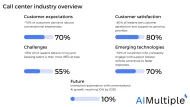
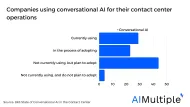
Comments
Your email address will not be published. All fields are required.